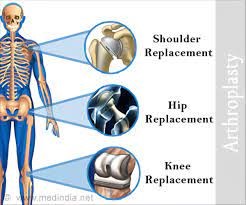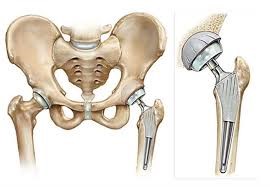THE KNEE REPLACEMENT PROCEDURE
Arthroplasty is a surgical procedure to restore the function of a joint. A joint can be restored by resurfacing the bones. An artificial joint (called a prosthesis) may also be used. Various types of arthritis may affect the joints. Osteoarthritis, or degenerative joint disease, is a loss of the cartilage or cushion in a joint, and is the most common reason for arthroplasty.
Knee replacement is performed in an operating room after you are given anesthesia. The surgery takes two to three hours. After surgery, you will be monitored in a recovery area for several hours, until the effects of the anesthesia wear off


.
Most people stay in the hospital for one or two nights after surgery, although shorter stays are becoming more common and many procedures are even done on an outpatient basis (ie, not requiring a hospital stay).
After surgery, you will be given pain medicines to help control any discomfort from the procedure.
- Whenever possible, non-opioid medicines will be used to help minimize pain.
- Some opioid medicines may be needed for a few weeks, particularly before physical therapy and sleep.
:Blood clots in the legs (called deep vein thromboses or "DVT") are a common concern after knee replacement surgery. To reduce the risk of blood clots, you can
- Get up and moving as soon as possible – Work with your physical therapist to try and get up the day of surgery or the day after. Learn exercises to do while in bed.
- Take an anti-clotting medication – You will take an anticoagulant medicine ("blood thinner"), either as a pill or a shot. Most people continue to take this medicine for a few weeks after surgery.
- Wear compression boots (devices that go around the legs and inflate periodically) while you are lying down – Once you are able to get up and walk, your doctor may suggest wearing antiembolism stockings. These stockings fit snugly around the foot, ankle, lower leg, and knee to help prevent blood clots.
Infection is another major concern, and you will be given antibiotics within an hour of the procedure and for up to 24 hours after. Eating a healthy diet, avoiding obesity, controlling blood sugars if diabetic, and smoking cessation all are helpful for minimizing infection risk.
Rehabilitation — You will be encouraged to start moving your feet and ankles immediately after surgery. It is common to begin physical therapy the day of or the day after surgery. Active motion of the knee is encouraged.
Physical therapy is an important part of the recovery process. After leaving the hospital, some people have physical therapy in their home or at a clinic, while others stay in a rehabilitation facility or nursing home for a few days.
The rehabilitation program generally includes exercises to improve range of motion (how far you can bend and straighten your knee) and to strengthen your leg muscles. Your surgeon and physical therapist will help to set goals as you progress through rehabilitation. It is important to avoid overworking or straining the knee during the recovery period. You can usually resume your normal daily activities within three to six weeks after surgery. After several months of rehabilitation, you will be able to have a more active lifestyle. High-impact sports such as running and sports that involve heavy contact (football) are not recommended, but you should be able to participate in activities like walking, bicycling, and swimming.
Potential complications — Serious complications are not common after knee replacement. However, any surgery comes with risks, and it is important to be aware of this. Your doctor will discuss the potential complications with you in detail.
Studies have shown that a successful joint replacement partially depends upon the experience of the surgeon and the hospital. Finding an experienced surgeon and a hospital where joint replacements are routinely done will likely improve your chances of a successful procedure with improved knee function and minimal complications.
The following are some of the more common complications that may occur after total knee replacement:
Blood clot — Having total knee replacement increases the risk of a blood clot forming in a vein. The most common place for a clot to develop after knee surgery is in the deep veins of the leg (called a deep vein thrombosis or DVT). This is a concern because a clot can be deadly if it travels to the lungs (doctors call this a pulmonary embolism). Call your doctor's office if you have symptoms that could indicate a DVT, such as leg pain or swelling.
Infection — Infection following knee replacement is a relatively uncommon but serious complication. Signs of infection include fever, chills, pain in the knee that gets worse suddenly, increasing redness, or swelling. Call your doctor's office if you are worried that you could have an infection.
Wound infections are treated with antibiotics and occasionally by draining excess fluid from the joint. If an infection becomes deep or extensive, the prosthetic joint may need to be removed and reimplanted later, after the infection has cleared.
Stiffness — Occasionally, despite physical therapy, a patient's knee may get stiff and may not bend or straighten properly. If this occurs, then the patient may return to the operating room in order to bend and/or straighten the knee under anesthesia.
Early failure — The majority of knee replacements will last between 15 to 20 years. However, early failures may occur due to a variety of reasons. These include loosening of the implants, infection, fractures of the bone around the implants, and instability. When early failures occur, revision surgery may be necessary.
Because knee implants typically do not last much longer than 20 years, people who get a knee replacement at a younger age are more likely to require revision surgery. Younger people are more likely to live for longer than the lifespan of their implant; they may also have a more active lifestyle, which can put strain on the implant, contributing to failure over time. For these reasons, doctors are cautious about recommending knee replacement in people younger than 50.
Persistent pain/dissatisfaction — Approximately 15 percent of patients who undergo total knee replacement may have persistent pain or will not be satisfied with the outcome of the procedure. However, most people experience significant reduction or elimination of pain.